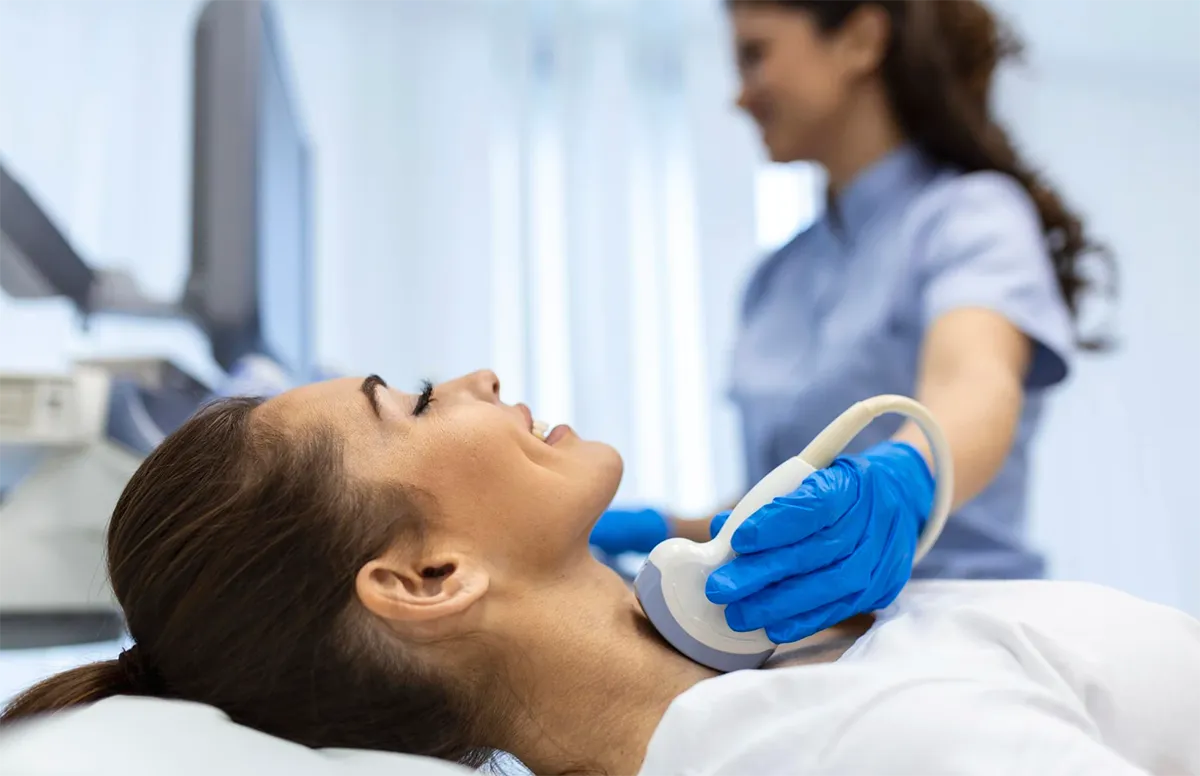Your session is about to expire
Learn More About Thyroid Research Studies
What are Thyroid Research Studies?
The thyroid is a little gland wrapped around the windpipe and present in front of the neck. It produces hormones that assist in regulating multiple critical bodily processes.
The phrase “thyroid disease” refers to a group of illnesses that prevent the thyroid from producing enough hormones. The thyroid typically produces the necessary hormones for optimal body function. The body will quickly use up its energy reserve when the thyroid produces excessive amounts of thyroid hormone. This is known as hyperthyroidism.
More than just making you fatigued, quick depletion of energy can also quicken your heartbeat, make you lose weight unintentionally, and cause anxiety. Contrarily, the thyroid may produce too little thyroid hormone. It is known as hypothyroidism. When the body produces too little thyroid hormone, it can cause you to feel exhausted, put on weight, and struggle to withstand cold weather.
Numerous causes can lead to these two illnesses. They may also be inherited from family members (hereditary).
Approximately 20 million people in the United States are thought to have some form of thyroid dysfunction, making thyroid illness relatively prevalent. About five to eight times as many women as men are impacted by thyroid problems.

Why is Thyroid Being Studied Through Research Studies?
The participants in a thyroid clinical trial are volunteers in a meticulously controlled and closely monitored clinical study. These study volunteers must meet enrollment requirements to be qualified to take part. The criteria are chosen while considering the research findings’ reliability and the participants’ security.
Thyroid clinical trials are designed to assess a medicine or medical device’s efficacy, safety, or appropriate dose regimen in patients with thyroid disease. Before being administered to the general population, new medications must be reviewed.
Here is a list of a few thyroid research achievements to demonstrate the broad significance:
An estimated 250,000 Americans suffer from thyroid nodules each year. Clinical studies done by scientists have produced low-cost techniques for examining thyroid nodules for the presence of malignancies. Other essential studies have created new instruments for the surveillance of thyroid cancer patients.
Thousands of cases of mental retardation have been averted thanks to early detection and treatment and studies done decades ago. Pediatric research is currently attempting to identify links between maternal and baby thyroid disorders and their long-term implications on children’s cognitive development.
Researchers have gathered the preliminary data necessary for successful grant submissions to the National Institutes of Health thanks to research funds supporting groundbreaking studies in thyroid hormone function and brain development. A promising genetic research study on Graves’ illness involving 100 families could result in better prognoses and preventive medications. An autoimmune condition known as Graves’ disease, which is expected to affect 1% of the population, is genetically transmitted.
The investigation of an experimental medicine that may be helpful for the therapy and prevention of Graves’ ophthalmopathy has developed from a decade of research on the condition. It has also increased scientific understanding of the cellular mechanisms involved in this devastating eye illness.
Early thyroid researchers explained the process of thyroid-pituitary feedback. The interaction between the thyrotropin-releasing hormone and its receptor to control cellular function in the pancreas, heart, eyes, and central nervous system is the subject of a groundbreaking new study.
Researchers are studying the effects of nuclear fallout on the thyroid gland and external head and neck radiation; they are working to eradicate iodine deficiency globally, utilizing their scientific training and results from public health studies.
What Are the Types of Treatments Available For Thyroid?
Because the symptoms of thyroid disease are sometimes mistaken for those of other conditions, diagnosing it can occasionally be challenging. The elderly or those who are pregnant might have symptoms that are comparable to those with thyroid illness. Luckily, there are diagnostic tests that can assist in determining whether the origin of symptoms is a thyroid problem. These tests are:
- Physical exams
- Blood tests
- Imaging tests
The doctor's objective is to get the thyroid hormone levels back to normal. There are numerous ways to accomplish this, and the one they choose will depend on what caused the particular thyroid problem.
Treatment options for hyperthyroidism, which is characterized by elevated thyroid hormone levels, can include:
- Anti-thyroid medications, such as methimazole and propylthiouracil, prevent the thyroid from producing hormones.
- Radioactive iodine: This procedure destroys the thyroid's cells and stops them from producing extra thyroid hormones.
- Beta-blockers: These drugs help manage the symptoms but don't alter the number of hormones in the body.
- Surgery: The doctor might surgically remove the thyroid as a more long-term therapeutic option (thyroidectomy). As a result, it won't produce hormones. But the patient will require thyroid replacement hormones for the rest of their life.
The main course of treatment for hypothyroidism, or low thyroid hormone levels, is:
- Thyroid replacement medication: This is a synthetic technique to replenish the body's supply of thyroid hormones. Levothyroxine is one such common medication. You can control thyroid disease and lead a normal life by taking medicine.

What Are Some of the Breakthrough Clinical Trials Involving Thyroid?
2022: Endocrine system after 2 years of COVID-19 vaccines: A narrative review of the literature - This study details what is currently known about probable endocrine side effects following COVID-19 vaccinations.
Case reports, series, original investigations, and reviews authored and published in Web of Science, PubMed/MEDLINE, and Scopus research were chosen and reviewed. A definitive reference list was created based on how each work related to this review’s subject matter.
The results indicated that endocrine adverse effects were typically uncommon and had a positive outcome, with thyroid issues being the most prevalent. Contrarily, information on type 1 diabetes is scarce, and anecdotal reports of adrenal and pituitary occurrences exist. Lastly, the clinical trials indicate no effect on male and couple fertility and the female reproductive system.
2022: Masked CKD in hyperthyroidism and reversible CKD status in hypothyroidism- In a retrospective and longitudinal study, 52 patients with hypothyroidism and 88 with hyperthyroidism were included to examine the changes in renal function and the factors that influenced those changes after therapy for thyroid diseases.
After treatment, the thyroid function improved, and the estimated glomerular filtration rate (eGFR) significantly decreased in hyperthyroidism and increased in hypothyroidism. The results of the multiple linear regression analysis showed that age, eGFR, and FT3 were identified as independent explanatory variables in hypothyroidism. In contrast, sex, eGFR, free thyroxine (FT4), and free triiodothyronine (FT3) were found to be independent explanatory variables in hyperthyroidism. Additionally, the classification of participants with hyperthyroidism by kidney function before and after therapy for thyroid issues showed that 4.5% of them had pre-defined non-CKD and post-defined CKD, demonstrating the occurrence of “masked” CKD in hyperthyroidism. However, 13.5% of the subjects with hypothyroidism exhibited post-defined non-CKD and pre-defined CKD, showing that hypothyroidism might cause “reversible” CKD status.
By identifying the population with hidden CKD in hyperthyroidism and reversible CKD in hypothyroidism, researchers could highlight the significance of routine thyroid function testing in CKD patients and a follow-up kidney function check following hyperthyroidism treatment.
2022: IVF/ICSI outcomes of euthyroid infertile women with thyroid autoimmunity: does treatment with aspirin plus prednisone matter? - A multicenter, retrospective analysis was carried out in three reproductive facilities from 2017 to 2020. 494 euthyroid infertile women who had undergone their first in-vitro fertilization and embryo transfer cycle tested positive for thyroglobulin antibodies, anti-thyroperoxidase, and thyroid-stimulating hormone (TSH) levels ranging from 0.35 to 4.0mIU/L were recruited. In the end, 346 women were chosen, of whom 150 received treatment with aspirin (100 mg/d) and prednisone (10 mg/d). The 196 untreated women remained in the control group. The day of the embryo transfer marked the beginning of treatment, which persisted until a clinical pregnancy was established.
For the first embryo transfer cycles, the clinical pregnancy rate was 63.5% vs. 57.5% in the treatment and control groups, and for frozen-thawed embryo transfer cycles, it was 61.8% vs. 57.8%. Additionally, the fresh embryo transfer had a live birth rate of 49.6% as opposed to 47.3% in the treatment and control groups. Aspirin and prednisone did not reduce the clinical pregnancy or miscarriage rate, according to the results of logistic regression. Furthermore, it was found that high miscarriage rates were linked to low free triiodothyronine (FT3) levels.
The study proved that regardless of the embryo type, adjuvant treatment of P + A after the embryo transfer isn’t required in euthyroid women with thyroid autoimmunity having their first IVF-ET.
2021: Effect of thyroidectomy in patients with tracheal compression - This study’s objectives were to assess the impact of thyroidectomy conducted as a result of tracheal compression and determine the degree of relief using magnetic resonance imaging (MRI).
This study comprised 30 patients—6 men and 24 women—who underwent complete thyroidectomy and had tracheal constriction due to enlarged thyroid glands. MRIs were taken six months before and after surgery. Researchers recorded, compared, and statistically analyzed the tracheal lateral and anteroposterior (AP) diameters and the degree of deviation from the trachea midline.
The statistical analysis showed significant differences in lateral and AP diameters and pre-and postoperative tracheal deviations. Histopathologically, there was no difference between benign and malignant pathology in improving the tracheal anatomy following surgery.
The study proved that architecture significantly improves following thyroidectomy for tracheal compression. Thyroidectomy should be among the first alternatives explored in the thyroid treatment of disorders with compression findings due to its quick and effective results.
2017: Prevalence of thyroid dysfunction and its impact on cognition in older Mexican adults: (SADEM study) - This study sought to determine if thyroid function affects the cognitive status of senior citizens and the frequency of thyroid dysfunction within older adults.
One thousand seven hundred fifty individuals from the Study on Aging and Dementia were included in the analysis. Each individual received a clinical evaluation through specific interviews. TSH levels were evaluated using a chemiluminescent immunometric technique. Participants were divided into five groups based on their thyroid condition: TSH values between 0.40 and 4.0 IU/L were deemed normal; overt hyperthyroidism was defined as TSH 0.3 IU/l and FT4 >23 pmol/l; overt hypothyroidism as TSH >4.8 IU/l and FT4 13 pmol/l; subclinical hyperthyroidism as TSH 0.3 IU/l and subclinical hypothyroidism as TSH >4.8 IU/l and FT4: 13-23 pmol/l.
The current investigation showed that the elderly Mexican residents of the community had a significant prevalence of thyroid dysfunction. The occurrence of hypothyroidism was linked to cognitive impairment, though less so in the case of hyperthyroidism.